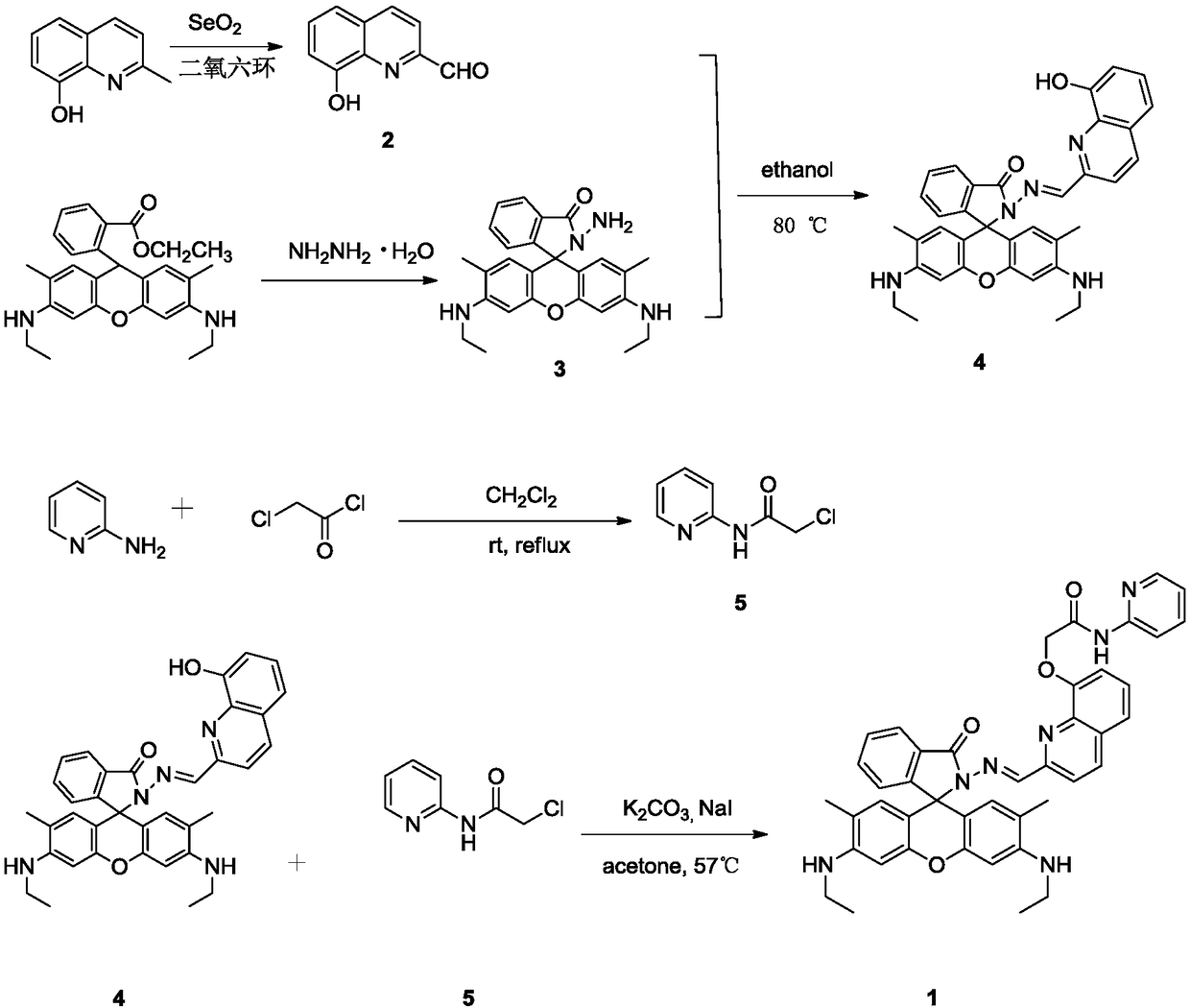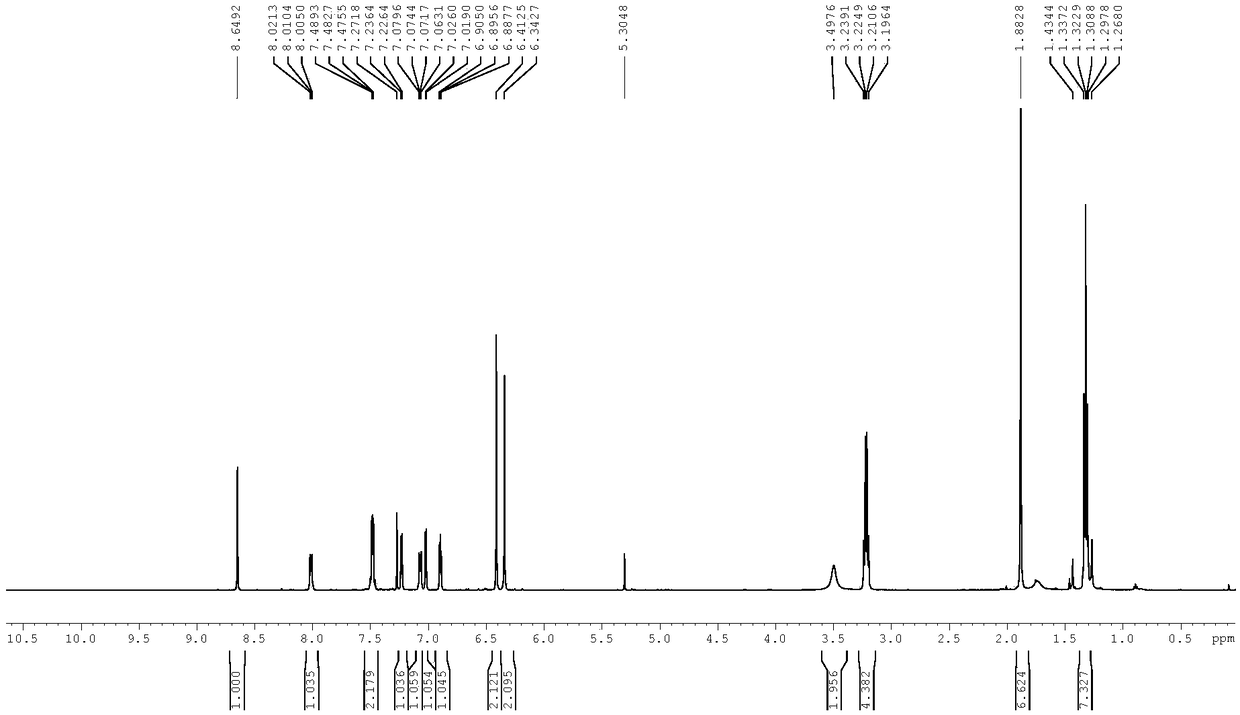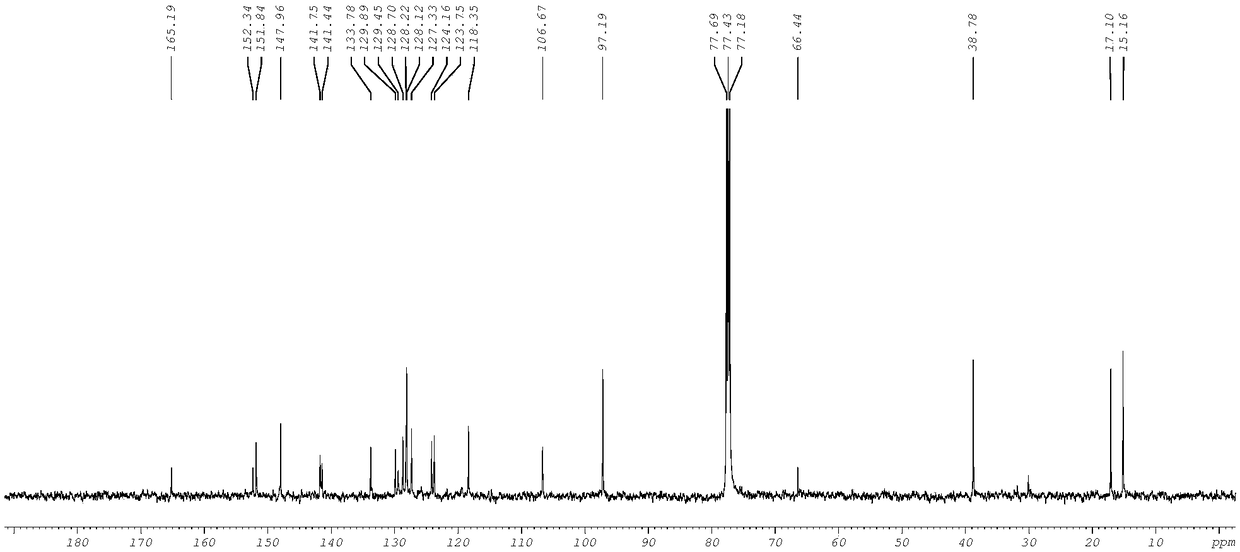A kind of rhodamine 6g-based chromium ion detection fluorescent probe molecule, preparation method and application
A fluorescent probe, chromium ion technology, applied in the field of chromium ion detection, can solve the problems of complex sample preparation, high detection cost, long test process, etc., and achieve the effects of good cell permeability, short resolution time, and small side effects.
- Summary
- Abstract
- Description
- Claims
- Application Information
AI Technical Summary
Problems solved by technology
Method used
Image
Examples
Embodiment 1
[0038] Example 1: Synthesis of fluorescent probe molecules for detection of chromium ions based on rhodamine 6G
[0039] For specific synthetic routes, see figure 1 .
[0040](1) Preparation of 2-formyl-8-hydroxyquinoline: 0.32 g of 2-methyl-8-hydroxyquinoline (2 mmol) was dissolved in 20 mL of dioxane. Heat to 60°C, then weigh 0.27g of SeO 2 It was added to the above solution, and then the temperature was raised to 80° C., and the reaction mixture was heated to reflux for 10 hours under the protection of nitrogen. After the reaction, the reaction liquid was cooled to room temperature, and the obtained precipitate was washed with 8 mL of dioxane and 8 mL of dichloromethane, filtered, and vacuum-dried. The obtained crude product was passed through a silica gel chromatography column and eluted with petroleum ether: ethyl acetate = 9:1 (v:v), and the eluate was concentrated to obtain 0.14 g of a light yellow compound. Yield 40.5%. 1 H-NMR (500MHz, CDCl 3 ):δ10.2(s,1H),8.31-...
Embodiment 2
[0045] Example 2: Selectivity of fluorescent probe molecules for chromium ion detection based on rhodamine 6G for ultraviolet detection of chromium ions
[0046] Using CH 3 CN (acetonitrile): Tris-HCl buffer (trishydroxymethylaminomethane) (0.01mol / L, pH=7.4)=9:1 (v:v) solution controls the experimental conditions.
[0047] Chromium ion detection fluorescent probe molecules based on rhodamine 6G 3 CN:Tris-HCl=9:1 (v:v) was dissolved in a solvent and fixed to a 100mL volumetric flask to prepare a solution with a fluorescent probe molecular concentration of 10 μmol / L.
[0048] Divide the sample vials into 12 groups, add 5mL of rhodamine 6G-based chromium ion detection fluorescent probe molecules with a concentration of 10 μmol / L to each sample vial 3 CN: Tris-HCl (0.01mol / L, pH=7.4) = 9:1 (v:v) solution, the first bottle of solution was used as a blank group, and 75 μL of K with a concentration of 0.1mol / L was added to the other 11 groups + , Na + ,Co 2+ , Ni 2+ ,Zn 2+ ,P...
Embodiment 3
[0051] Example 3: Selectivity of fluorescent probe molecules for chromium ion detection based on rhodamine 6G for chromium ion fluorescence detection
[0052] Using CH 3 CN (acetonitrile): Tris-HCl (0.01mol / L, pH=7.4) = 9:1 (v:v) solution controls the experimental conditions.
[0053] Chromium ion detection fluorescent probe molecules based on rhodamine 6G 3 CN:Tris-HCl=9:1 (v:v) was dissolved in a solvent and fixed to a 100mL volumetric flask to prepare a solution with a fluorescent probe molecular concentration of 10 μmol / L.
[0054] Divide the sample vials into 12 groups, add 5mL of rhodamine 6G-based chromium ion detection fluorescent probe molecules with a concentration of 10 μmol / L to each sample vial 3 CN: Tris-HCl (0.01mol / L, pH=7.4) = 9:1 (v:v) solution, the first bottle of solution is used as a blank group, and 75 μL of K with a concentration of 0.1mol / L were added to the other 11 groups + , Na + ,Co 2+ , Ni 2+ ,Cu 2+ ,Zn 2+ ,Pb 2+ ,Cd 2+ , Li + , Fe 3+ ,...
PUM
 Login to View More
Login to View More Abstract
Description
Claims
Application Information
 Login to View More
Login to View More - R&D
- Intellectual Property
- Life Sciences
- Materials
- Tech Scout
- Unparalleled Data Quality
- Higher Quality Content
- 60% Fewer Hallucinations
Browse by: Latest US Patents, China's latest patents, Technical Efficacy Thesaurus, Application Domain, Technology Topic, Popular Technical Reports.
© 2025 PatSnap. All rights reserved.Legal|Privacy policy|Modern Slavery Act Transparency Statement|Sitemap|About US| Contact US: help@patsnap.com



